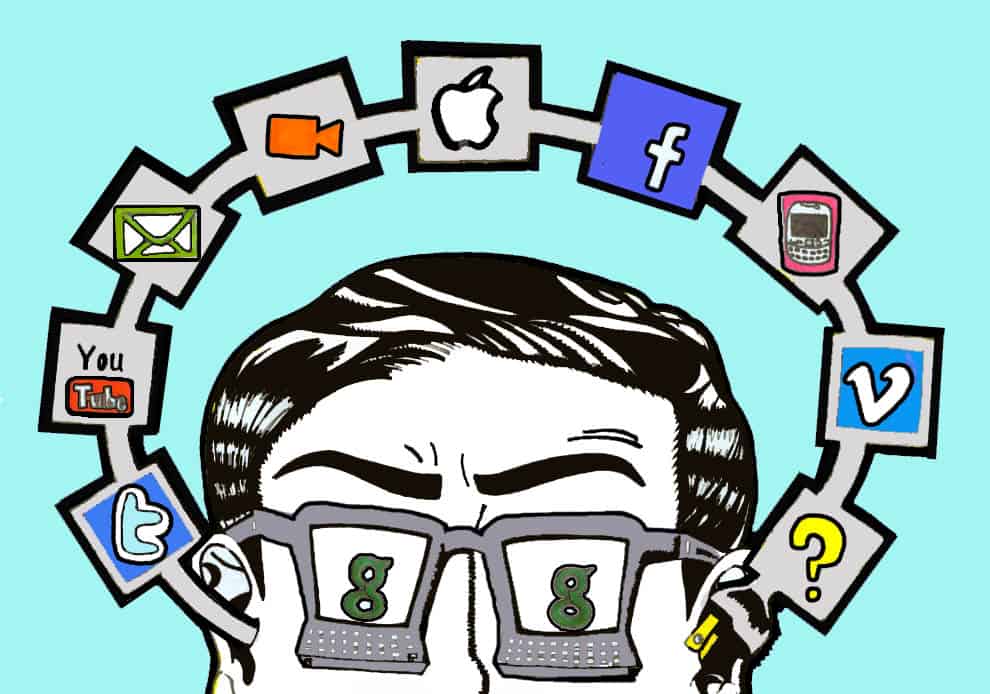A whole new facet of learning is being introduced to postsecondary classrooms.
Most professors have strayed from using chalk and blackboard for some time, in exchange for projectors to display lecture slides, or even clips from YouTube. But now, in an effort to encourage deeper involvement and learning for students, many professors have begun to integrate new media into their lectures.
In many classes, students can now watch lectures online and participate in class discussions on Facebook, Twitter, or even microblogging site Tumblr. They can retrieve course material and supplementary readings without having to enter the classroom.
“The web option is really inventing the future,” says Brian Sutherland, a professor at UTM and educational technology administrator for UTSC. “What’s exciting is we can’t know what the benefit is, since it hasn’t really been tried before.”
You could say the classes are in beta testing.
By embracing social media that students have traditionally used as a distraction from tedious lectures, professors have discovered a new and successful way of extending learning outside of class hours.
“I do use Twitter quite a lot to circulate research ideas and communicate with students,” Sutherland says. “Social media is a really powerful communications phenomenon that can’t be ignored. These tools have the potential to amplify any message to the entire world if it resonates with people.”
Professors can also send students updates on class cancellations, projects, guest lecturers and learning opportunities like live-chatting with an author in another country.
American literature professor Ira Wells runs a Tumblr for his ENG365 Contemporary American Fiction course.
Wells posts ideas and thoughts about lectures, projects, and a music list that he feels complements the readings. He recently hosted a live-chat with Danielle Dutton, whose novel, Sprawl, is on the class syllabus.
“I would never have found the money to fly her to Toronto and facilitate a conversation, so the live-blogging experience turned out to be ideal,” Wells says. “Every student in the class could interact with the author in real time. It was a unique experience.”
Although the use of Tumblr is a bit atypical, many professors will now post lecture slides or audio recordings of their classes, as well as readings and assignments online.
Kiera Tremblay, who endures a two-hour commute to UTSC, is appreciative of the option for online coursework.
“It helps save me time and money, and it gives everyone a chance to stay up-to-date on everything the class is doing and any changes to the course or assignments,” she says. “This leaves nothing to chance in case you miss a class one day and miss an important announcement.”
Sutherland suggests that having coursework online causes students to spend more time with the material, which in turn helps students improve in class.
“Lecture recordings allow students to review the academic narrative multiple times, pause, repeat, reflect and take time to really think and synthesize their experiences — what educators call the ‘deep learning,’” he says.
However, not all professors are as willing to embrace media integration into classrooms.
“I had a professor for three of my classes who hated using projectors and lecture slides,” says U of T student Gillian Worton-Scott. “A lot was missed because he moved quickly from topic to topic, and they were difficult concepts to grasp.”
Other professors prohibit the use of laptops in their lectures or won’t use Blackboard.
Ignoring the integration of new media, however, might mean missing out on huge potential for heightened learning, Wells says.
“It just makes sense to extend our classroom conversations into other corners of our lives. Thinking doesn’t stop when the bell rings.”


